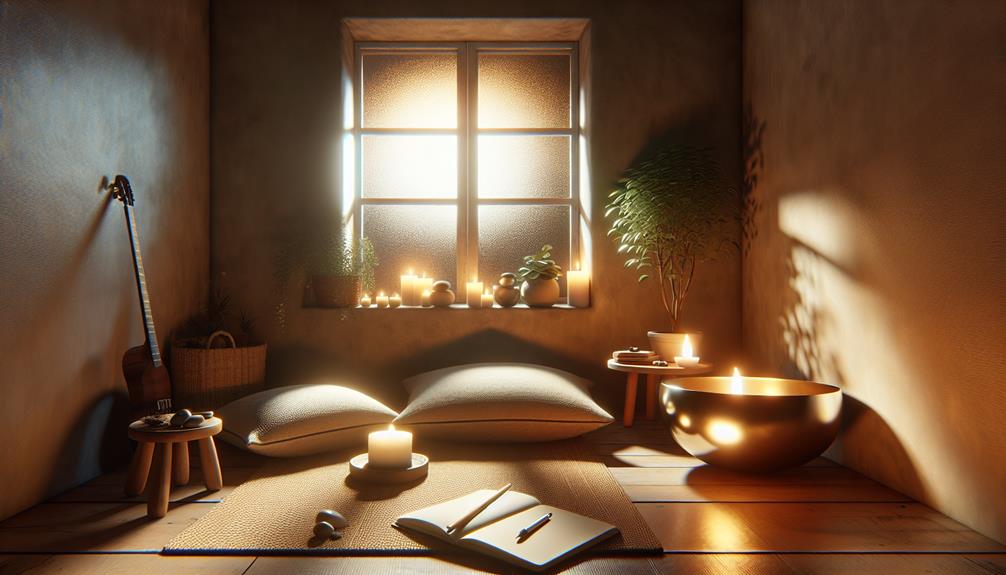To find inner peace amidst the hustle and bustle of everyday life, you must first learn to quiet the noise within you. By practicing mindfulness techniques and embracing gratitude as a daily ritual, you can start paving the path towards tranquility. However, these are just the beginning steps on your journey towards inner peace. Stay tuned to uncover more strategies that will help you navigate the complexities of a busy world while nurturing your inner calmness.
Key Takeaways
- Practice mindfulness to stay present and calm.
- Set boundaries to manage time and energy effectively.
- Simplify your environment by decluttering and organizing.
- Cultivate self-compassion and kindness towards yourself.
- Prioritize activities that align with your values for inner peace.
Understanding Inner Peace
To truly understand inner peace, it is essential to recognize that it is a state of calmness and harmony within oneself despite external circumstances. Achieving inner peace involves developing self-awareness through practices like meditation and mindfulness. Meditation benefits your mental and emotional well-being by allowing you to observe your thoughts without judgment, leading to a deeper understanding of yourself. Through mindfulness practice, you can cultivate emotional balance by staying present in the moment and accepting your feelings without letting them overpower you.
Mindful Breathing Techniques
Practice mindful breathing techniques to bring your focus to the present moment and cultivate a sense of calm within yourself. Breathing exercises are powerful tools that can help you manage stress and anxiety, promoting relaxation and inner peace. One effective technique is diaphragmatic breathing, where you focus on deep, slow breaths that expand your diaphragm. This type of breathing can help reduce the heart rate and activate the body’s relaxation response.
Another beneficial method is box breathing, a technique used by many to calm the mind and increase focus. Inhale for a count of four, hold your breath for a count of four, exhale for a count of four, and then hold your breath again for a count of four. Repeat this cycle several times to experience a sense of tranquility and mental clarity.
Simplifying Your Environment
Ready to create a sanctuary of peace in your surroundings? Declutter your space to invite calmness, organize your belongings for a clearer mind, and minimize distractions for a tranquil environment. Let’s simplify together for a more peaceful you!
Declutter for Calmness
Simplify your environment by decluttering to create a space that promotes calmness and peace within you. Embracing a minimalist lifestyle can notably impact your well-being by reducing visual noise and creating a serene space for relaxation. Clutter often leads to feelings of overwhelm and anxiety, making it challenging to find tranquility amidst chaos. By decluttering your surroundings, you allow room for clarity and peace to flourish.
Start small by tackling one area at a time, whether it’s your desk, closet, or living room. Ask yourself if each item brings you joy or serves a purpose. If not, consider letting it go. Remember, decluttering is not just about physical possessions but also about clearing mental clutter. Take a few moments each day to organize your thoughts and prioritize what truly matters to you.
As you simplify your environment, you’ll notice a shift in your mindset. A clutter-free space can help you feel more focused, energized, and at peace. Embrace the journey towards a minimalist lifestyle, and enjoy the tranquility that follows.
Organize for Clarity
To achieve clarity in your environment, consider organizing your space in a way that promotes calmness and focus. A cluttered environment can lead to a cluttered mind, making it difficult to concentrate and find peace within yourself. By tidying up your surroundings, you can create a sense of order that translates into a clear mind and focused energy.
Start by decluttering your space and getting rid of items you no longer need or that don’t bring you joy. Organize your belongings in a way that is visually appealing and makes it easy to find what you need. Use storage solutions like boxes, shelves, or baskets to keep things neat and tidy.
Creating designated areas for different activities can also help you maintain focus. Designate a specific spot for work, relaxation, and hobbies to separate your tasks and avoid distractions. By organizing your space with intention, you can cultivate a sense of peace and clarity that will enhance your overall well-being.
Minimize for Tranquility
When aiming to create a tranquil environment for inner peace, streamlining your surroundings can play a key role in fostering a sense of calm and clarity. To achieve this, start by decluttering your physical space. Remove items that no longer serve a purpose or bring you joy. Simplifying your environment can help reduce feelings of overwhelm and promote a more serene atmosphere.
Prioritizing self-care is essential in maintaining tranquility. Allocate time in your day for activities that nourish your mind, body, and soul. Whether it’s reading a book, taking a walk in nature, or enjoying a warm bath, self-care rituals can help you feel more grounded and centered.
Incorporating meditation techniques into your daily routine can further enhance your sense of tranquility. Find a quiet space, focus on your breath, and let go of any racing thoughts. Meditation can help quiet the mind, reduce stress, and cultivate a deeper sense of inner peace.
Practicing Gratitude Daily
You can start practicing gratitude daily by keeping a gratitude journal and jotting down things you’re thankful for each day. Engaging in mindful thankfulness exercises can also help you appreciate the present moment and cultivate a positive outlook. These practices can shift your focus from what’s lacking in your life to all the good that surrounds you, fostering inner peace amidst life’s busyness.
Daily Gratitude Journaling
Practicing daily gratitude journaling can greatly enhance your overall sense of well-being and contentment. Keeping a gratitude journal allows you to reflect on the positive aspects of your life, fostering a mindset of mindful appreciation. Here are some tips to help you get started:
- Consistent Routine: Set aside a specific time each day to write in your gratitude journal. Whether it’s in the morning to start your day on a positive note or at night to reflect on the day’s blessings, consistency is key.
- Specificity is Key: Instead of generic statements, try to be specific about what you are grateful for. This could be a small act of kindness from a colleague, a beautiful sunset you witnessed, or a delicious meal you enjoyed.
- Include Challenges: Don’t shy away from including challenges or setbacks in your gratitude journal. Reflecting on these moments with gratitude can help you find valuable lessons or silver linings in difficult situations.
Mindful Thankfulness Practice
Embracing a mindful thankfulness practice can greatly enhance your daily life and overall well-being. Incorporating gratitude meditation and thankful reflection into your routine can shift your focus towards positivity and appreciation. Start by setting aside a few minutes each day to reflect on what you are grateful for. This simple practice can help you cultivate a sense of abundance and contentment in your life.
During gratitude meditation, take deep breaths and bring to mind the things you are thankful for. It could be as simple as the warmth of the sun on your face or the laughter of a loved one. Allow yourself to fully experience the emotions associated with these moments of gratitude. This practice can help you feel more grounded and present in the moment, fostering a sense of peace and serenity.
Setting Boundaries and Priorities
In today’s fast-paced world, establishing clear boundaries and priorities is essential for maintaining your inner peace and well-being. Here are some practical steps to help you navigate this process:
- Effective Time Management: Utilize tools like calendars or apps to schedule your tasks and allocate time for activities that bring you joy and relaxation. Prioritize your to-do list based on importance and deadlines to avoid feeling overwhelmed.
- Enhance Communication Skills: Learn to assertively communicate your needs and limits to others. Setting boundaries through clear and respectful communication can help prevent burnout and foster healthier relationships. Remember, it’s okay to say no when necessary.
- Identify Your Priorities: Reflect on what truly matters to you and align your daily choices with your values. By focusing on what is most important, you can avoid distractions and invest your time and energy in activities that bring fulfillment and peace.
Cultivating Self-Compassion
Begin by recognizing your own humanity and embracing imperfections as part of your journey towards fostering self-compassion. Treating yourself with the same kindness and understanding that you would extend to a friend in a challenging situation is crucial. Engage in self-love practices and self-care routines regularly to nurture your emotional well-being. Make time for activities that bring you joy and relaxation, whether it involves reading a book, enjoying a leisurely bath, or going for a stroll in nature.
To enhance your self-compassion, consider integrating compassion exercises and empathy-building techniques into your daily routine. Practice mindfulness to increase your awareness of your thoughts and feelings without passing judgment. When dealing with obstacles or setbacks, remind yourself that making mistakes is a natural aspect of the learning process. Treat yourself with patience and kindness, just as you would console a loved one experiencing a challenging period.
Frequently Asked Questions
How Do I Deal With Distractions During Mindfulness Practice?
When managing interruptions in mindfulness, staying focused helps. Overcome external distractions by maintaining clarity. Stay present, gently guide your attention back if distractions arise. Be kind to yourself, it’s all part of the practice.
Can Practicing Gratitude Really Improve My Mental Well-Being?
Practicing gratitude can indeed enhance your mental well-being. Gratitude exercises, supported by scientific evidence, can boost your mood and mindset. Journaling, a technique rooted in positive psychology, helps cultivate thankfulness and inner peace.
What Are Some Effective Ways to Say No and Set Boundaries?
When setting boundaries, assertive communication is key. Remember, saying no is healthy. Prioritize self-care by managing stress effectively. Establish personal boundaries to protect your well-being. Embrace the power of saying no for your mental health.
How Can I Maintain Inner Peace When Facing Difficult Situations?
When facing tough times, remember to practice coping strategies like mindful breathing. Build emotional resilience by managing stress effectively. You can maintain inner peace by prioritizing self-care and setting healthy boundaries.
Is Self-Compassion Different From Self-Care?
Self-compassion involves treating yourself with kindness during tough times, whereas self-care focuses on activities that nurture your well-being. Both are essential for self-love and acceptance, forming a foundation for inner peace in challenging situations.
Conclusion
Remember, finding inner peace in a busy world is a journey, not a destination. By incorporating mindfulness practices, simplifying your environment, and setting boundaries, you are taking important steps towards creating a more harmonious life. Embrace self-compassion, prioritize activities that bring you joy, and remember to be kind to yourself along the way. With dedication and intention, you can cultivate a sense of calmness and balance amidst the chaos of everyday life. You deserve inner peace, so keep working towards it.



